Top tips to prepare your joints for winter

Whether you struggle with joint pain throughout the year or simply start to feel the strain during winter, joint aches and pains can have a massive impact on your daily routine. Through a selection of simple changes, such as installing a stairlift for your home and making alterations to your diet, you can lower the number of problems that might incur as a result of conditions such as gout and arthritis. Discover how you can decrease the amount of pain experienced with our top tips below.
Clothing

Wrapping up warm in winter is imperative, regardless of whether or not you experience joint aches and pain. From thick jumpers and waterproof coats to socks and gloves, your body requires extra items of clothing in order to help it retain heat, especially if you’re spending a lot of time outdoors. The easiest way to ensure that you stay warm is by layering clothing. By using multiple thin layers over one or two bulkier items, you can move more freely, in addition to adapting to the changing temperatures by removing or adding a layer as you see fit.
Starting with a good base layer, thermal underwear is a fantastic option as it acts as insulation. When experiencing joint pain, it is important to consider the weight of your clothing, as you want to limit the amount of extra strain that you’re placing on your body. A fleece worn underneath a waterproof jacket will keep you protected from the elements without making you feel overwhelmed with clothing.
Your feet and ankles can struggle the most with the drop in temperature. However, it is important that they can still be mobile, giving your joints as much room to move around as possible. Avoid wearing large, fluffy socks with shoes as they often restrict the amount of movement you may have. A great alternative is a pair made with Lycra or nylon, as these allow a thin layer of air to act as insulation.
Food

Indulging in home-cooked, hearty meals throughout the colder months can be incredibly helpful when it comes to warming you up inside. However, the food that you eat over the course of winter can also have a positive impact at minimising the effects of arthritis and other often debilitating joint aches and pains.
Inflammation is one of the leading causes of joint irritation, causing damage to the tissue around the bones. Managing your diet carefully can help reduce this, with antioxidants removing toxins from your body to ease the pain. Although you can take supplements to give you the recommended dose, the easiest way to make sure that you’re getting enough antioxidants is through eating a plethora of different fruits and vegetables, such as berries, sweet potatoes and tomatoes.
With inflammation in mind, there is also a list of foods that those suffering from joint pain should try their best to avoid. Although it should come as no surprise that eating an excessive amount of fried food is bad for your body, it should especially be avoided if you’re experiencing a period of bad joint pain. Whilst it adds weight to your body, putting an additional strain to your bones, fried foods also produce a certain set of hormones which increase levels of inflammation.
Although all joint pain can cause a hindrance in day-to-day life, gout can have one of the most detrimental impacts. Caused by excess levels of uric acid, crystals begin to form around the joins, resulting in reduced mobility, redness and intense pain which suddenly occurs. Despite there being medication to manage this, what you eat can help further reduce symptoms.
Keeping hydrated by drinking plenty of water is first and foremost the easiest way to ease the side effects of gout, as well as eating foods which are high in anthocyanins, such as cherries. In addition, coffee and low-fat dairy products can also lower the levels of uric acid in the body, decreasing the likelihood of your body creating crystals.
Exercise

When you’re in pain, exercise can sometimes be the last thing for you to consider. However, it is vital for you to keep moving, even through the colder months. Remaining active when you struggle with joint pain is crucial. Not only does it increase your strength and improve your flexibility, but it can help to reduce the pain that you may be experiencing by strengthening muscles to support your joints.
Although exercise can help reduce the pain, you will need to consider the strain that it can put on other parts of your body, especially through winter. Short bursts of gentle exercise across the week reduce the likelihood of injury, especially in comparison to long sessions of strenuous activity. Focus on finding the right balance between aerobic exercises, such as swimming or cycling, and exercises that focus on weight training.
The time of the day which you choose to exercise can have a massive impact on how well it goes. After a long sleep, your joints need time to loosen up, as they will have had limited movement during the night. As the day progresses, your joints will warm up and become more flexible, reducing the levels of pain that you may experience during exercise. Opting for late morning or early afternoon will also give any medication that you may be taking time to kick in, which is also incredibly beneficial if you’re planning on working out.



